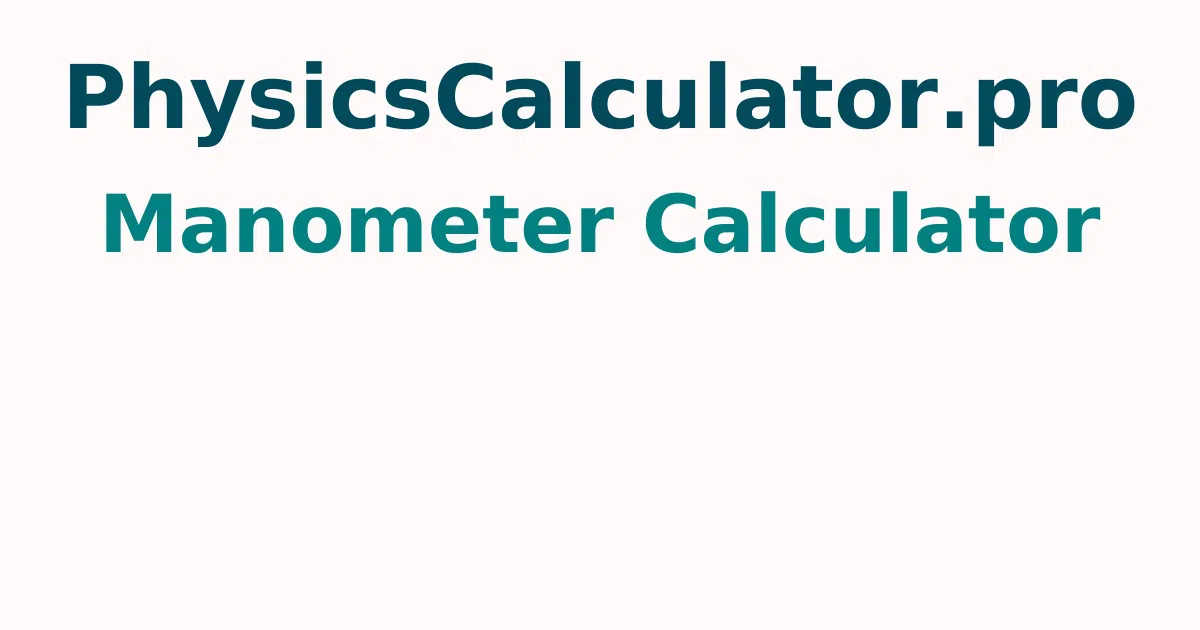Manometer Calculator
Easy-to-use online manometer calculator makes it simple to determine a fluid's hydrostatic pressure. Simply fill in the necessary fields of the calculation with the type of manometer, the manometer's attachment position, air pressure, density, and liquid height. To quickly find the outcome, press the blue to calculate button.
What is Manometer?
A manometer is a basic device for measuring fluid pressure. It has a pipe with a uniform glass tube linked to it. It's just a tube that's used to monitor pressure variations caused by fluids and atmospheric pressure interacting. A manometer usually contains high-density liquid mercury, although it can also contain water or any other liquid.
Pascal's principle governs the operation of a manometer. The pressure applied to a section of an enclosed incompressible liquid will be transferred equally in all directions through the fluid, according to Pascal's principle.
Toothpaste is an excellent example of a manometer. To calculate the manometer pressure, formulae or hydrostatic pressure equations are used.
P = ρgh
P = ρ1 * g * h1 + (-)ρ2 * g * h2 is the pressure equation for a u-tube manometer attached to a pipe.
- Where, P = pressure of the liquid
- h = height
- ρ = liquid density
- g = acceleration due to gravity
How do you Calculate Hydrostatic Pressure?
To simply determine the hydrostatic pressure of a manometer, follow the methods outlined below.
- Step 1: From the question, determine the type of manometer, the location of the manometer, atmospheric pressure, density, and liquid height.
- Step 2: Multiply the density of the liquid, the acceleration due to gravity, and the height of the liquid.
- Step 3: The result is referred to as the liquid's pressure.
For more concepts check out physicscalculatorpro.com to get quick answers by using this free tool.
Manometer Calculation Examples
Question 1: One end of a single column manometer is connected to the atmosphere, while the other is an open tank. Find the gauge pressure and absolute pressure if the ambient pressure is 1034 Pa and the liquid density is 1070 kg/m^3 and the liquid height is 0.4 m.
Given:
Atmospheric Pressure = 1034 Pa
Liquid density = 1070 kg/m^3
Liquid height = 0.4 m
Gauge Pressure is P = ρgh
Put the values in the formula
P = 1070 * 0.4 * 9.8
P = 4194.4 Pa
Absolute pressure = 4194.4 - 1034
= 3160.4 Pa
Hence, gauge pressure is 4194.4 Pa and absolute pressure is 3160.4 Pa
FAQs on Manometer Calculator
1. How do you use a manometer to calculate pressure?
Density x acceleration due to gravity x liquid height is the formula for calculating pressure with a manometer. To determine the pressure, you must find the product of these three parameters.
2. Where do u tube manometers go?
A manometer is pressure or flow measuring equipment having a tiny tube in the shape of a U that is filled with liquid. A U-tube manometer is used to check whether the mitigation system's fan is running.
3. What is the purpose of a manometer test?
A manometer is a device that measures the difference in pressure between two gases, most commonly the atmosphere and the gas under test. A standard manometer is made out of a U-shaped tube that is filled with mercury or liquid. A measurement scale in millimetres is marked on the tube's long sides.
4. What does the h difference in height mean?
The quantity of vacuum is indicated by the difference in height, "h," which is the total of the measurements above and below zero. Manometers are instruments that use this idea.
5. What's the best way to create a simple manometer?
A measuring device should be placed on the side of the manometer that is opposite the expected pressure. Align the zero point of the measurement equipment with the liquid's surface and fasten it with tape. Depending on the application, the measuring device could be a ruler or graph paper.
